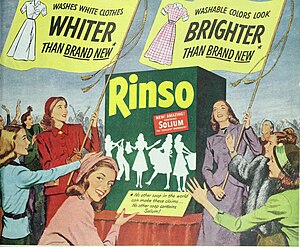
Back Publicidat AN إعلان Arabic বিজ্ঞাপন Assamese Reklam Azerbaijani تبلیغات AZB Реклама Bashkir Weabung BAR Рэклама Byelorussian Рэкляма BE-X-OLD I'lan BEW

| Marketing |
|---|
Advertising is the practice and techniques employed to bring attention to a product or service. Advertising aims to present a product or service in terms of utility, advantages and qualities of interest to consumers. It is typically used to promote a specific good or service, but there are a wide range of uses, the most common being commercial advertisement.
Commercial advertisements often seek to generate increased consumption of their products or services through "branding", which associates a product name or image with certain qualities in the minds of consumers. On the other hand, ads that intend to elicit an immediate sale are known as direct-response advertising. Non-commercial entities that advertise more than consumer products or services include political parties, interest groups, religious organizations, and governmental agencies. Non-profit organizations may use free modes of persuasion, such as a public service announcement. Advertising may also help to reassure employees or shareholders that a company is viable or successful.
In the 19th century, soap businesses were among the first to employ large-scale advertising campaigns. Thomas J. Barratt was hired by Pears to be its brand manager—the first of its kind—and in addition to creating slogans and images he recruited West End stage actress and socialite Lillie Langtry to become the poster-girl for Pears, making her the first celebrity to endorse a commercial product.[1] Modern advertising originated with the techniques introduced with tobacco advertising in the 1920s, most significantly with the campaigns of Edward Bernays, considered the founder of modern, "Madison Avenue" advertising.[2][3]
Worldwide spending on advertising in 2015 amounted to an estimated US$529.43 billion.[4] Advertising's projected distribution for 2017 was 40.4% on TV, 33.3% on digital, 9% on newspapers, 6.9% on magazines, 5.8% on outdoor and 4.3% on radio.[5] Internationally, the largest ("Big Five") advertising agency groups are Omnicom, WPP, Publicis, Interpublic, and Dentsu.[6]
In Latin, advertere means "to turn towards".[7]
- ^ Cite error: The named reference
Endorsewas invoked but never defined (see the help page). - ^ Donley T. Studlar (2002) Tobacco Control: Comparative Politics in the United States and Canada Archived May 9, 2016, at the Wayback Machine p.55 quotation: "... from the early days advertising has been intimately intertwined with tobacco. The man who is sometimes considered the founder of modern advertising and Madison Avenue, Edward Bernays, created many of the major cigarette campaigns of the 1920s, including having women march down the street demanding the right to smoke."
- ^ Donald G. Gifford (2010) Suing the Tobacco and Lead Pigment Industries Archived May 10, 2016, at the Wayback Machine, p.15 quotation: "... during the early twentieth century, tobacco manufacturers virtually created the modern advertising and marketing industry as it is known today."
- ^ "Carat Predicts Positive Outlook in 2016 with Global Growth of +4.7%". Carat. September 22, 2015. Archived from the original on October 1, 2015. Retrieved September 30, 2015.
- ^ Vranica, Suzanne; Marshall, Jack (October 20, 2016). "Plummeting Newspaper Ad Revenue Sparks New Wave of Changes". Wall Street Journal. Archived from the original on March 11, 2017.
- ^ Parekh, Rupal; Patel, Kunur (July 12, 2012). "Not the 'Big Four' Holding Firms in Adland Anymore – Now It's the Big Five". Advertising Age. Archived from the original on February 15, 2015. Retrieved January 18, 2014.
- ^ "Latin Word Study Tool - adverto". Perseus Digital Library. Retrieved October 31, 2017.